Ecosystem Management Policy Implications Based on Tonga Main Tuna Species Catch Data 2002–2018
Abstract
:1. Introduction
2. Tonga’s Tuna Fisheries and Management Strategies
2.1. National Obligations: An Information-Based Management
2.2. Improving Profitability and Sustainability through Governance
2.2.1. Governance in Implementing and Monitoring Catch Regulations
2.2.2. Contribution to Economy and Livelihood
2.2.3. Governance of Fleet Size Control
2.2.4. Fishing within the EEZ
3. Methods
3.1. Fishery Data
3.2. Environmental Data
3.3. Index for Spatio-Temporal Distribution Mapping
4. Results
4.1. Spatio-Temporal Distribution of Four Main Tuna Species 2002–2018
4.2. Tuna Habitats in Relation to Biological and Physical Oceanic Conditions
4.3. Tuna and Climate Variability
5. Discussion
6. Conclusions
Supplementary Materials
Author Contributions
Funding
Institutional Review Board Statement
Data Availability Statement
Acknowledgments
Conflicts of Interest
References
- Barclay, K.; Cartwright, I. Governance of tuna industries: The key to economic viability and sustainability in the western and central pacific ocean. Mar. Policy 2007, 31, 348–358. [Google Scholar] [CrossRef]
- Bell, J.D.; Kronen, M.; Vunisea, A.; Nash, W.J.; Keeble, G.; Demmke, A.; Pontifex, S. Planning the use of fish for food security in the pacific. Mar. Policy 2009, 33, 64–76. [Google Scholar] [CrossRef]
- Goodman, C.; Davis, R.; Azmi, K.; Bell, J.; Galland, G.R.; Gilman, E.; Haas, B.; Hanich, Q.; Lehodey, P.; Manarangi-Trott, L.; et al. Enhancing cooperative responses by regional fisheries management organisations to climate-driven redistribution of tropical Pacific tuna stocks. Front. Mar. Sci. 2022, 9, 1046018. [Google Scholar] [CrossRef]
- Seto, K.; Miller, N.; Young, M.Q. Toward transparent governance of transboundary fisheries: The case of Pacific tuna transshipment. Mar. Policy 2022, 136, 104200. [Google Scholar] [CrossRef]
- Bayliff, W.H. The fisheries for tunas in the eastern pacific ocean. In Advances in Tuna Aquaculture; Elsevier: Amsterdam, The Netherlands, 2016; pp. 21–41. [Google Scholar]
- MAFF; FFA. Tonga Tuna Fishery Framework 2018–2022; Ministry of Agriculture, Forestry and Fisheries: Tokyo, Japan; Fishery Forum Agency: Nuku’alofa, Tonga, 2018. [Google Scholar]
- Ram-Bidesi, V.; Tsamenyi, M. Implications of the tuna management regime for domestic industry development in the pacific island states. Mar. Policy 2004, 28, 383–392. [Google Scholar] [CrossRef]
- Havice, E. The structure of tuna access agreements in the western and central pacific ocean: Lessons for vessel day scheme planning. Mar. Policy 2010, 34, 979–987. [Google Scholar] [CrossRef]
- Dalzell, P.; Kingma, E.; Bailey, A.S.; Ha, P.; McGregor, M.; Tosatto, M.D. Amendment 7 Fishery Ecosystem Plan for Pelagic Fisheries of the Western Pacific Region Regarding the Use and Assignment of Catch and Effort Limits of Pelagic Management Unit Species by the Us Pacific Island Territories and Specification of Annual Bigeye Tuna Catch Limits for the Us Pacific Island Territories: Including An Environmental Assessment and Regulatory Impact Review; RIN, 0648-BD46; Western Pacific Fishery Management Council: Honolulu, HI, USA; National Oceanic and Atmospheric Administration: Honolulu, HI, USA, 2014. [Google Scholar]
- McCoy, M.A. Regulation of Transshipment by the Western and Central Pacific Fisheries Commission: Issues and Considerations for FFA Member Countries; Gillett, Preston & Associates: Santa Barbara, CA, USA, 2007. [Google Scholar]
- Langley, A.; Hampton, J.; Ogura, M. Stock Assessment of Skipjack Tuna in the Western and Central Pacific Ocean; WCPFC SC1 SA WP-4. Bigeye tuna Yellowfin tuna; Western and Central Pacific Fisheries Commission: Kolonia, Micronesia, 2005. [Google Scholar]
- McIlgorm, A. Economic impacts of climate change on sustainable tuna and billfish management: Insights from the western pacific. Prog. Oceanogr. 2010, 86, 187–191. [Google Scholar] [CrossRef]
- Van Dyke, J.; Haftel, S. Tuna management in the pacific: An analysis of the south pacific forum fisheries agency. Univ. Hawaiʻi Law Rev. 1981, 3, 1. [Google Scholar]
- Gillett, R.; Lightfoot, C. The Contribution of Fisheries to the Economies of Pacific Island Countries; Asian Development Bank: Mandaluyong, Philippines, 2001. [Google Scholar]
- Williams, P.; Terawasi, P. Overview of Tuna Fisheries in the Western and Central Pacific Ocean, including Economic Conditions—2010; WCPFC-SC7-2011/GN WP-1; Western and Central Pacific Fisheries Commission: Kolonia, Micronesia, 2011. [Google Scholar]
- Bell, J.D.; Allain, V.; Allison, E.H.; Andréfouët, S.; Andrew, N.L.; Batty, M.J.; Blanc, M. Diversifying the use of tuna to improve food security and public health in pacific island countries and territories. Mar. Policy 2015, 51, 584–591. [Google Scholar] [CrossRef]
- Aranda, M.; de Bruyn, P.; Murua, H. A report review of the tuna RFMOs: CCSBT, IATTC, IOTC, ICCAT and WCPFC. EU FP7 Proj. 2010, 212188, 125–171. [Google Scholar]
- Abolhassani, A. Scalar politics in transboundary fisheries management: The Western and Central Pacific Fisheries Commission as an eco-scalar fix for South Pacific albacore tuna management. Mar. Policy 2023, 152, 105583. [Google Scholar] [CrossRef]
- Havice, E. Unsettled sovereignty and the sea: Mobilities and more-than-territorial configurations of state power. Ann. Am. Assoc. Geogr. 2018, 108, 1280–1297. [Google Scholar] [CrossRef]
- Brouwer, S.; Pilling, G.; Hampton, J.; Williams, P.; McKechnie, S.; Tremblay-Boyer, L. The Western and Central Pacific Tuna Fishery: 2017 Overview and Status of Stocks; Tuna Fisheries Assessment Report; Pacific Community: Nouméa, New Caledonia, 2018; p. 18. [Google Scholar]
- Preston, G.L. Review of Fisheries Management Issues and Regimes in the Pacific Islands Region (No. 17); SPREP: Apia, Samoa, 2017. [Google Scholar]
- Loring, P.A.; Fazzino, D.V.; Agapito, M.; Chuenpagdee, R.; Gannon, G.; Isaacs, M. Fish and food security in small-scale fisheries. In Transdisciplinarity for Small-Scale Fisheries Governance: Analysis and Practice; Springer: Berlin/Heidelberg, Germany, 2019; pp. 55–73. [Google Scholar]
- Bailey, H.R.; Kurby, C.A.; Giovannetti, T.; Zacks, J.M. Action perception predicts action performance. Neuropsychologia 2013, 51, 2294–2304. [Google Scholar] [CrossRef]
- Hanich, Q.; Tsamenyi, M. Developments in cooperative approaches to fisheries management in the pacific islands region. In From Hook to Plate: The State of Marine Fisheries, a Commonwealth Perspective; Bourne, R., Collins, N.M., Eds.; Commonwealth Foundation: London, UK, 2009; pp. 69–86. [Google Scholar]
- Havice, E. Rights-based management in the Western and Central Pacific Ocean tuna fishery: Economic and environmental change under the Vessel Day Scheme. Mar. Policy 2013, 42, 259–267. [Google Scholar] [CrossRef]
- Miller, K.A. Climate variability and tropical tuna: Management challenges for highly migratory fish stocks. Mar. Policy 2007, 31, 56–70. [Google Scholar] [CrossRef]
- Aqorau, T. Tuna Fisheries Management in the Western and Central Pacific Ocean: A Critical Analysis of the Convention for the Conservation and Management of Highly Migratory Fish Stocks in the Western and Central I Pacific Ocean and Its Implications for the Pacific Island States. Int. J. Mar. Coast. Law 2001, 16, 379–431. [Google Scholar]
- Bassett, H.R.; Sharan, S.; Suri, S.K.; Advani, S.; Giordano, C. A comparative study of small-scale fishery supply chains’ vulnerability and resilience to COVID-19. Marit. Stud. 2022, 21, 173–192. [Google Scholar] [CrossRef]
- Crona, B.I.; Basurto, X.; Squires, D.; Gelcich, S.; Daw, T.M.; Khan, A.; Havice, E.; Chomo, V.; Troell, M.; Buchary, E.A.; et al. Towards a typology of interactions between small-scale fisheries and global seafood trade. Mar. Policy 2016, 65, 1–10. [Google Scholar] [CrossRef]
- Link, J.S.; Huse, G.; Gaichas, S.; Marshak, A.R. Changing how we approach fisheries: A first attempt at an operational framework for ecosystem approaches to fisheries management. Fish Fish. 2020, 21, 393–434. [Google Scholar] [CrossRef]
- Morishita, J. What is the ecosystem approach for fisheries management? Mar. Policy 2008, 32, 19–26. [Google Scholar] [CrossRef]
- Heenan, A.; Pomeroy, R.; Bell, J.; Munday, P.L.; Cheung, W.; Logan, C.; Brainard, R.; Amri, A.Y.; Aliño, P.; Armada, N.; et al. A climate-informed, ecosystem approach to fisheries management. Mar. Policy 2015, 57, 182–192. [Google Scholar] [CrossRef]
- Evans, K.; Young, J.; Nicol, S.; Kolody, D.; Allain, V.; Bell, J.; Brown, J.N. Optimising fisheries management in relation to tuna catches in the western central pacific ocean: A review of research priorities and opportunities. Mar. Policy 2015, 59, 94–104. [Google Scholar] [CrossRef]
- Yeeting, A.D.; Bush, S.R.; Ram-Bidesi, V.; Bailey, M. Implications of new economic policy instruments for tuna management in the western and central pacific. Mar. Policy 2016, 63, 45–52. [Google Scholar] [CrossRef]
- Gillett, R.; Tauati, M.I. Fisheries of the Pacific Islands: Regional and National Information; FAO Fisheries and Aquaculture Technical Paper: Food; Agriculture Organization of the United Nations: Rome, Italy, 2018; pp. 1–400. [Google Scholar]
- Kronen, M.; Vunisea, A.; Magron, F.; McArdle, B. Socio-economic drivers and indicators for artisanal coastal fisheries in pacific island countries and territories and their use for fisheries management strategies. Mar. Policy 2010, 34, 1135–1143. [Google Scholar] [CrossRef]
- Sibert, J.; Hampton, J. Mobility of tropical tunas and the implications for fisheries management. Mar. Policy 2003, 27, 87–95. [Google Scholar] [CrossRef]
- Gillett, R.; McCoy, M.; Rodwell, L.; Tamate, J. Tuna: A key economic resource in the pacific islands. A report prepared for the asian development bank and the forum fisheries agency. In Tuna: A Key Economic Resource in the Pacific Islands. A Report Prepared for the Asian Development Bank and the Forum Fisheries Agency; Asian Development Bank: Mandaluyong, Philippines, 2001. [Google Scholar]
- Kawaley, I. Implications of exclusive economic zone management and regional cooperation between south pacific small midocean island commonwealth territories. Ocean. Dev. Int. Law 1999, 30, 333–377. [Google Scholar] [CrossRef]
- Stone, K.; Fenner, D.; LeBlanc, D.; Vaisey, B.; Purcell, I.; Eliason, B. Tonga. World Seas: An Environmental Evaluation; Elsevier: Amsterdam, The Netherlands, 2019; pp. 661–678. [Google Scholar]
- National Oceanic and Atmospheric Administration. Sea Surface Temperature & Sea Surface Chlorophyll; National Oceanic and Atmospheric Administration: Honolulu, HI, USA, 2021. [Google Scholar]
- Wickham, H. ggplot2: Elegant Graphics for Data Analysis; Springer: New York, NY, USA, 2016. [Google Scholar]
- R Core Team. R: A Language and Environment for Statistical Computing. R Foundation for Statistical Computing. 2021. Available online: https://www.R-project.org/ (accessed on 24 March 2019).
- Wickham, H.; François, R.; Henry, L.; Müller, K. Dplyr: A Grammar of Data Manipulation. 2022. Available online: https://github.com/tidyverse/dplyr (accessed on 12 June 2019).
- Microsoft Corporation. Microsoft Excel. Available online: https://office.microsoft.com/excel (accessed on 14 September 2022).
- Robinson, J.; Guillotreau, P.; Jiménez-Toribio, R.; Lantz, F.; Nadzon, L.; Dorizo, J.; Gerry, C. Impacts of climate variability on the tuna economy of seychelles. Clim. Res. 2010, 43, 149–162. [Google Scholar] [CrossRef]
- Kim, W.; Yeh, S.-W.; Kim, J.-H.; Kug, J.-S.; Kwon, M. The unique 2009–2010 el niño event: A fast phase transition of warm pool el niño to la niña. Geophys. Res. Lett. 2011, 38, 1–5. [Google Scholar] [CrossRef]
- Hu, S.; Fedorov, A.V. The extreme el niño of 2015–2016 and the end of global warming hiatus. Geophys. Res. Lett. 2017, 44, 3816–3824. [Google Scholar] [CrossRef]
- Wester Amundsen, I. “Our Tuna, Our Wealth, Our Future”: Ensuring Sustainability and Social Justice in the Tuna Fisheries of the Western-Central Pacific. Master’s Thesis, Norwegian University of Life Sciences, Ås, Norway, 2016. [Google Scholar]
- Edwards, Z.; Sinan, H.; Adam, M.S.; Miller, A. State-led fisheries development: Enabling access to resources and markets in the Maldives pole-and-line skipjack tuna fishery. In Securing Sustainable Small-Scale Fisheries: Showcasing Applied Practices in Value Chains, Post-Harvest Operations and Trade; Food and Agriculture Organization: Rome, Italy, 2020; Volume 652, p. 141. [Google Scholar]
- Duggan, D.E.; Kochen, M. Small in scale but big in potential: Opportunities and challenges for fisheries certification of Indonesian small-scale tuna fisheries. Mar. Policy 2016, 67, 30–39. [Google Scholar] [CrossRef]
- Winther, J.G.; Dai, M.; Douvere, F.; Fernandes, L.; Halpin, P.; Hoel, A.H.; Juinio-Meñez, M.A.; Li, Y.; Morrissey, K.; Rist, T.; et al. Integrated Ocean Management; World Resources Institute: Washington, DC, USA, 2020; Volume 5. [Google Scholar]
- Sharp, G.D. Tuna oceanography—An applied science. Fish Physiol. 2001, 19, 345–389. [Google Scholar]
- Orúe, B.; Pennino, M.G.; Lopez, J.; Moreno, G.; Santiago, J.; Ramos, L.; Murua, H. Seasonal distribution of tuna and non-tuna species associated with drifting fish aggregating devices (DFADs) in the western Indian Ocean using fishery-independent data. Front. Mar. Sci. 2020, 7, 441. [Google Scholar] [CrossRef]
- Gillis, D.M. Ideal free distributions in fleet dynamics: A behavioral perspective on vessel movement in fisheries analysis. Can. J. Zool. 2003, 81, 177–187. [Google Scholar] [CrossRef]
- Hu, C.; Harrison, D.P.; Hinton, M.G.; Siegrist, Z.C.; Kiefer, D.A. Habitat analysis of the commercial tuna of the Eastern Tropical Pacific Ocean. Fish. Oceanogr. 2018, 27, 417–434. [Google Scholar] [CrossRef]
- Arrizabalaga, H.; Dufour, F.; Kell, L.; Merino, G.; Ibaibarriaga, L.; Chust, G. Global habitat preferences of commercially valuable tuna. Deep. Sea Res. Part II Top. Stud. Oceanogr. 2015, 113, 102–112. [Google Scholar] [CrossRef]
- Branch, T.A. How do individual transferable quotas affect marine ecosystems? Fish Fish. 2009, 10, 39–57. [Google Scholar] [CrossRef]
- Dunn, D.C.; Boustany, A.M.; Halpin, P.N. Spatio-temporal management of fisheries to reduce by-catch and increase fishing selectivity. Fish Fish. 2011, 12, 110–119. [Google Scholar] [CrossRef]
- Gordon, A.L.; Susanto, R.D.; Vranes, K. Cool Indonesian throughflow as a consequence of restricted surface layer flow. Nature 2003, 425, 824–828. [Google Scholar] [CrossRef]
- Sudre, J.; Morrow, R.A. Global surface currents: A high-resolution product for investigating ocean dynamics. Ocean. Dyn. 2008, 58, 101–118. [Google Scholar] [CrossRef]
- Mitchell, T.P.; Wallace, J.M. The annual cycle in equatorial convection and sea surface temperature. J. Clim. 1992, 5, 1140–1156. [Google Scholar] [CrossRef]
- Alvarez-Fernandez, S.; Riegman, R. Chlorophyll in north sea coastal and offshore waters does not reflect long term trends of phytoplankton biomass. J. Sea Res. 2014, 91, 35–44. [Google Scholar] [CrossRef]
- Wang, Y.; Gao, Z. Contrasting chlorophyll-a seasonal patterns between nearshore and offshore waters in the bohai and yellow seas, china: A new analysis using improved satellite data. Cont. Shelf Res. 2020, 203, 104173. [Google Scholar] [CrossRef]
- Lanz, E.; Nevárez-Martίnez, M.; López-Martίnez, J.; Dworak, J.A. Small pelagic fish catches in the gulf of california associated with sea surface temperature and chlorophyll. CalCOFI Rep. 2009, 50, 134–146. [Google Scholar]
- Atkinson, A.; Whitehouse, M.J.; Priddle, J.; Cripps, G.C.; Ward, P.; Brandon, M.A. South Georgia, Antarctica: A productive, cold water, pelagic ecosystem. Mar. Ecol. Prog. Ser. 2001, 216, 279–308. [Google Scholar] [CrossRef]
- Mackey, K.R.; van Dijken, G.L.; Mazloom, S.; Erhardt, A.M.; Ryan, J.; Arrigo, K.R.; Paytan, A. Influence of atmospheric nutrients on primary productivity in a coastal upwelling region. Glob. Biogeochem. Cycles 2010, 24, 4. [Google Scholar] [CrossRef]
- Whitney, F.; Crawford, W.; Harrison, P. Physical processes that enhance nutrient transport and primary productivity in the coastal and open ocean of the subarctic NE pacific. Deep. Sea Res. Part II Top. Stud. Oceanogr. 2005, 52, 681–706. [Google Scholar] [CrossRef]
- Rajapaksha, J.; Samarakoon, L.; Gunathilaka, A. Environmental preferences of yellowfin tuna in the northeast indian ocean: An application of satellite data to longline catches. Int. J. Fish. Aquat. Sci. 2013, 2, 72–80. [Google Scholar]
- Walters, C.; Maguire, J.-J. Lessons for stock assessment from the northern cod collapse. Rev. Fish Biol. Fish. 1996, 6, 125–137. [Google Scholar] [CrossRef]
- Harrison, D.P.; Hinton, M.G.; Kohin, S.; Armstrong, E.M.; Snyder, S.; O’Brien, F.; Kiefer, D.K. The pelagic habitat analysis module for ecosystem-based fisheries science and management. Fish. Oceanogr. 2017, 26, 316–335. [Google Scholar] [CrossRef]
- Setiawati, M.D.; Sambah, A.B.; Miura, F.; Tanaka, T.; As-syakur, A.R. Characterization of bigeye tuna habitat in the southern waters off java–bali using remote sensing data. Adv. Space Res. 2015, 55, 732–746. [Google Scholar] [CrossRef]
- Keyl, F.; Wolff, M. Environmental variability and fisheries: What can models do? Rev. Fish Biol. Fish. 2008, 18, 273–299. [Google Scholar] [CrossRef]
- Mainuddin, M.; Saiton, K.; Saiton, S. Albacore fishing ground in relation to oceanographic conditions in the western north pacific ocean using remotely sensed satellite data. Fish. Oceanogr. 2008, 17, 61–73. [Google Scholar] [CrossRef]
- Redondo-Rodriguez, A.; Weeks, S.J.; Berkelmans, R.; Hoegh-Guldberg, O.; Lough, J.M. Climate variability of the great barrier reef in relation to the tropical pacific and el nino-southern oscillation. Mar. Freshw. Res. 2012, 63, 34–47. [Google Scholar] [CrossRef]
- Syamsuddin, M.L.; Saitoh, S.-I.; Hirawake, T.; Bachri, S.; Harto, A.B. Effects of el niño–southern oscillation events on catches of bigeye tuna (Thunnus obesus) in the eastern indian ocean off java. Fish. Bull. 2013, 111, 175–188. [Google Scholar] [CrossRef]
- Vaihola, S.; Kininmonth, S. Climate Change Potential Impacts on the Tuna Fisheries in the Exclusive Economic Zones of Tonga. Diversity 2023, 15, 844. [Google Scholar] [CrossRef]
- Zhou, C.; Wan, R.; Cao, J.; Xu, L.; Wang, X.; Zhu, J. Spatial variability of bigeye tuna habitat in the pacific ocean: Hindcast from a refined ecological niche model. Fish. Oceanogr. 2021, 30, 23–37. [Google Scholar] [CrossRef]
- Lan, K.W.; Evans, K.; Lee, M.A. Effects of climate variability on the distribution and fishing conditions of yellowfin tuna (Thunnus albacares) in the western Indian Ocean. Clim. Change 2013, 119, 63–77. [Google Scholar] [CrossRef]
- Lehodey, P.; Senina, I.; Calmettes, B.; Hampton, J.; Nicol, S. Modelling the impact of climate change on Pacific skipjack tuna population and fisheries. Clim. Change 2013, 119, 95–109. [Google Scholar] [CrossRef]
- Senina, I.; Lehodey, P.; Calmettes, B.; Dessert, M.; Hampton, J.; Smith, N.; Gorgues, T.; Aumont, O.; Lengaigne, M.; Menkes, C.; et al. Impact of climate change on tropical Pacific tuna and their fisheries in Pacific Islands waters and high seas areas. In Proceedings of the 14th Regular Session of the Scientific Committee of the Western and Central Pacific Fisheries Commission, WCPFC-SC14, Busan, Republic of Korea, 8–16 August 2018. [Google Scholar]
- Berry, P.; Dawson, T.; Harrison, P.; Pearson, R. Modelling potential impacts of climate change on the bioclimatic envelope of species in britain and ireland. Glob. Ecol. Biogeogr. 2002, 11, 453–462. [Google Scholar] [CrossRef]
- Roandrianasolo Tsihoboto, M.; John, B.; Rijasoa, F. Analysis of Environmental Parameters Effects on the Spatial and Temporal Dynamics of Tropical Tuna in the EEZ of Madagascar: Coupling Remote Sensing and Catch Data; Universidad de Alicante, Instituto Interdisciplinar para el Estudio del: Alicante, Spain, 2015. [Google Scholar]
- Wiryawan, B.; Loneragan, N.; Mardhiah, U.; Kleinertz, S.; Wahyuningrum, P.I.; Pingkan, J.; Timur, P.S.; Duggan, D.; Yulianto, I. Catch per unit effort dynamic of yellowfin tuna related to sea surface temperature and chlorophyll in Southern Indonesia. Fishes 2020, 5, 28. [Google Scholar] [CrossRef]
- Lan, K.W.; Shimada, T.; Lee, M.A.; Su, N.J.; Chang, Y. Using remote-sensing environmental and fishery data to map potential yellowfin tuna habitats in the tropical pacific ocean. Remote Sens. 2017, 9, 444. [Google Scholar] [CrossRef]
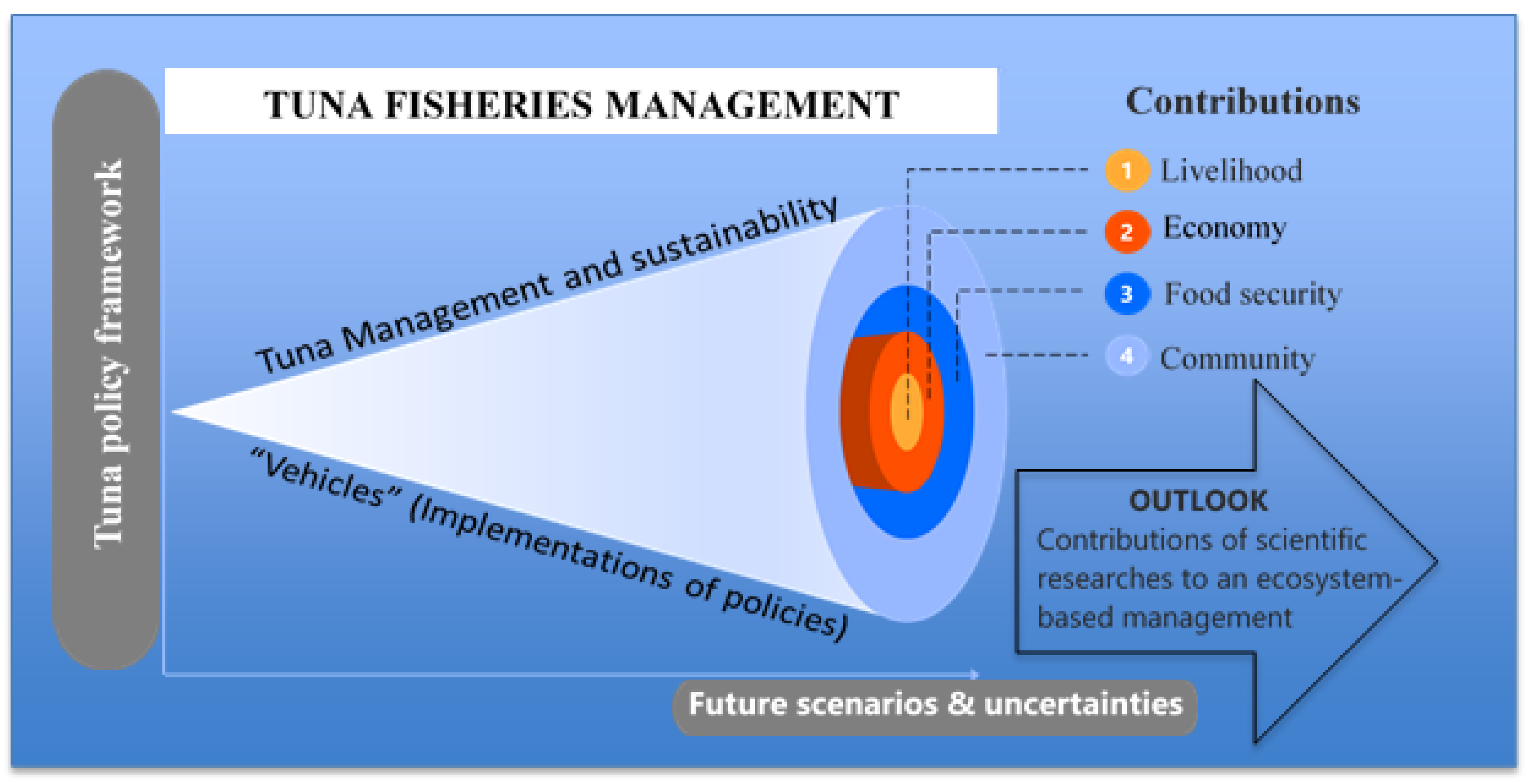
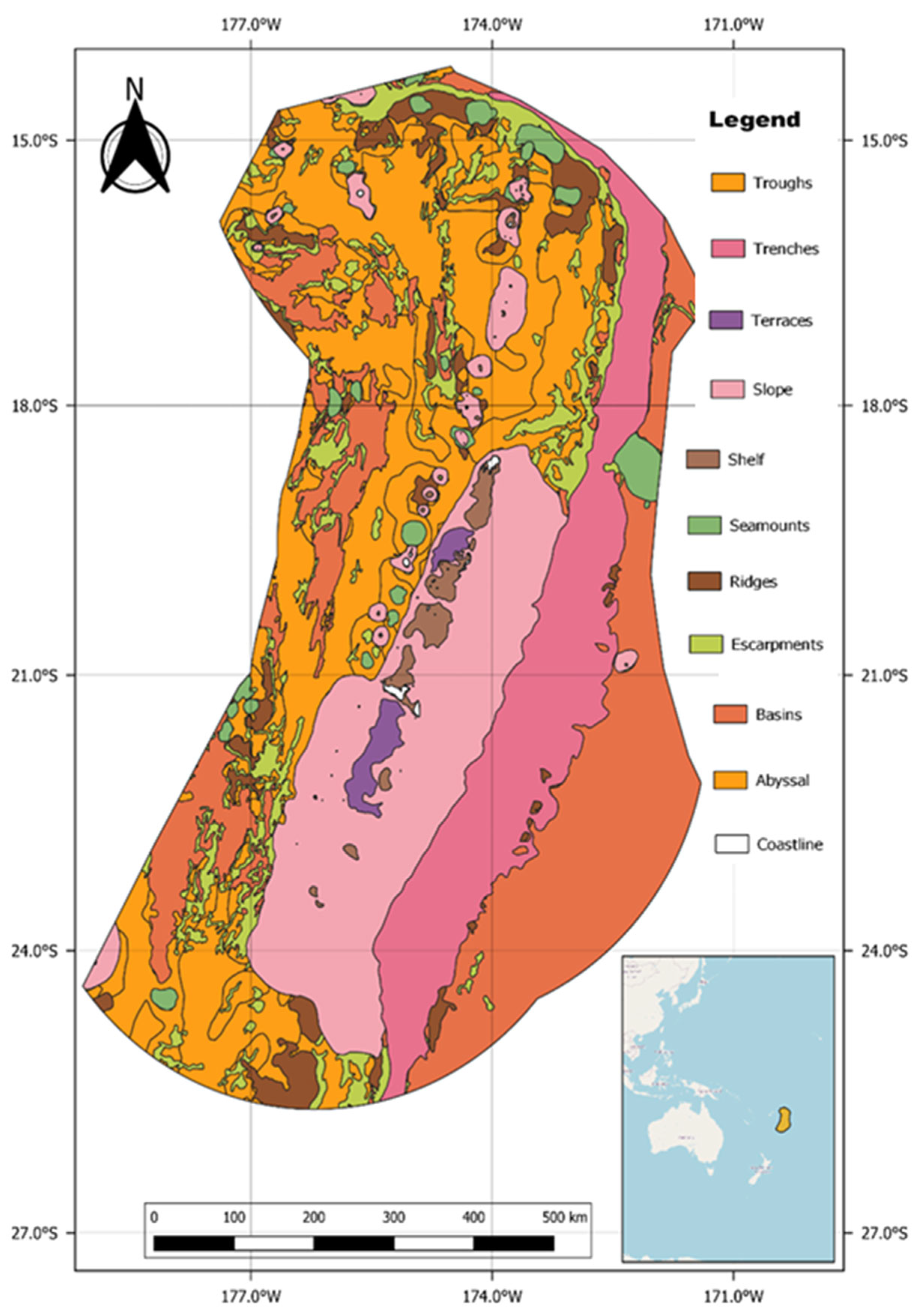
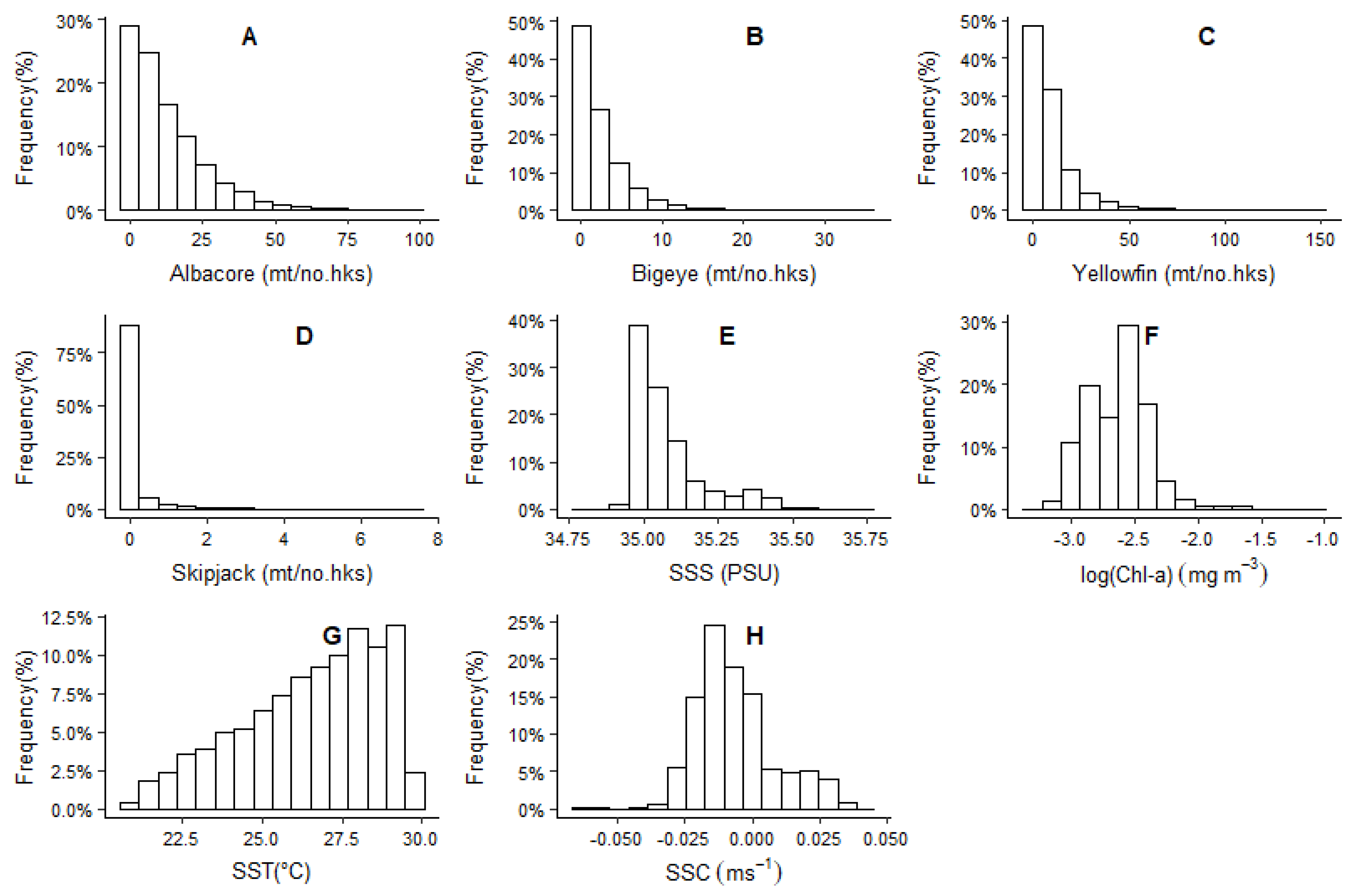
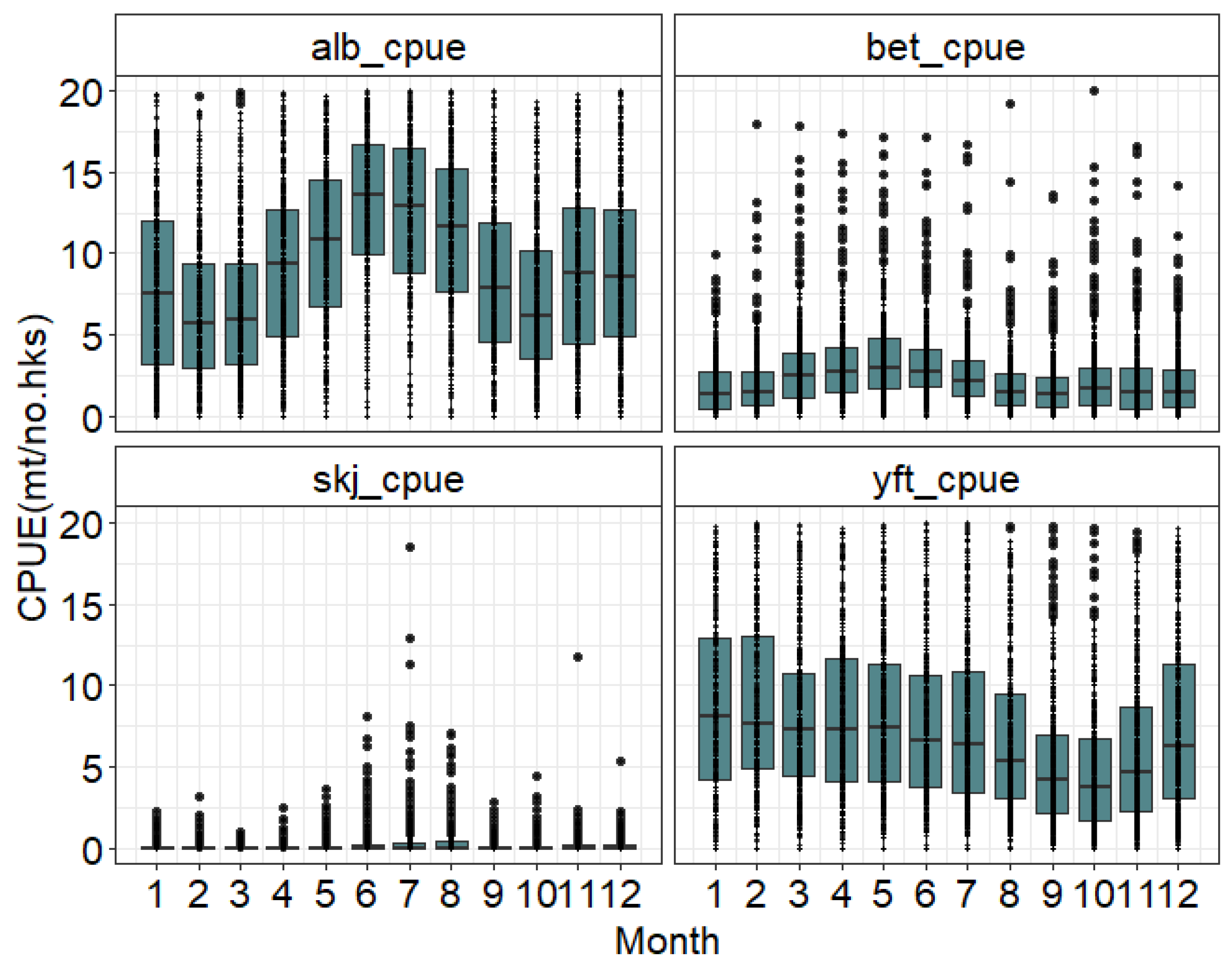
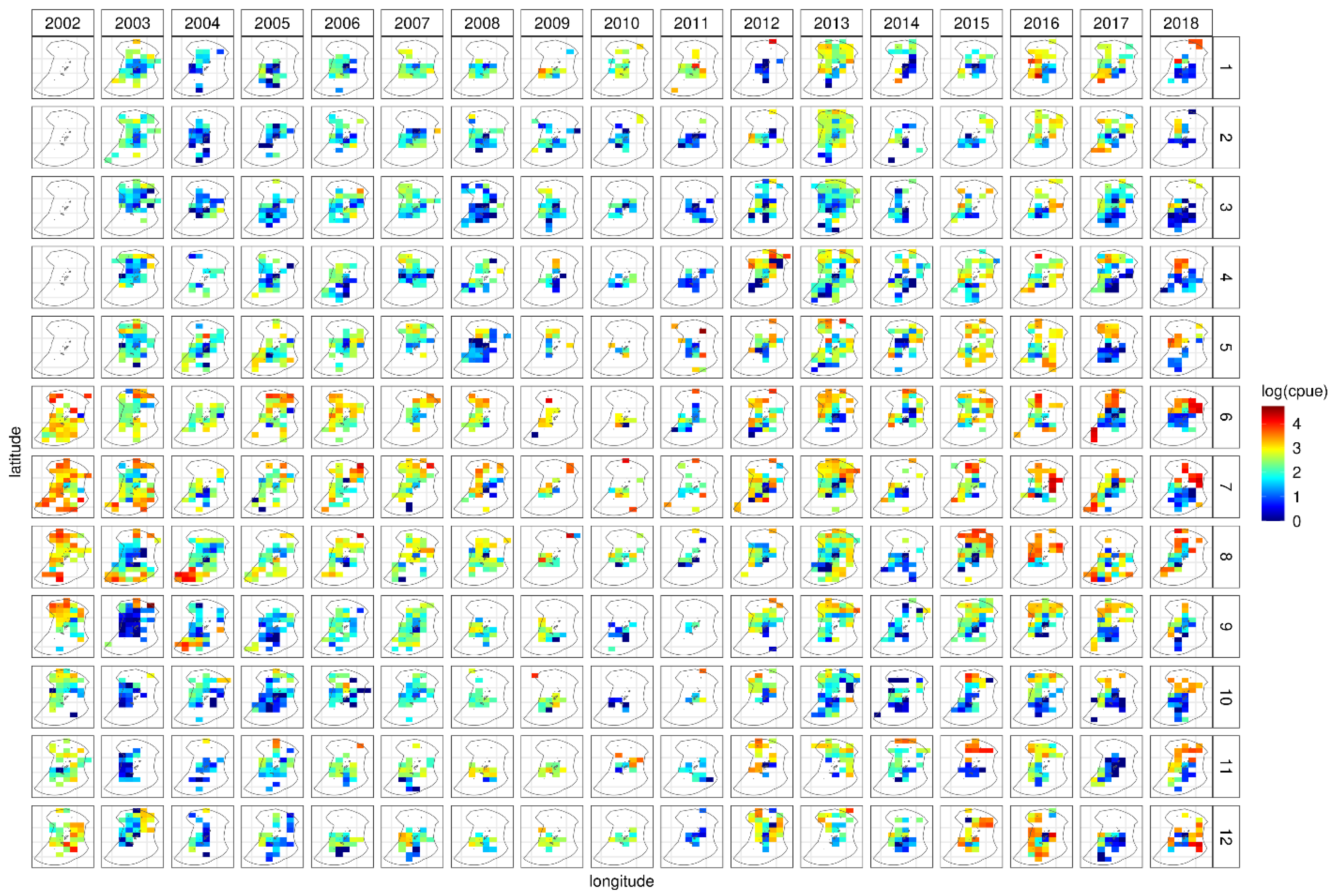
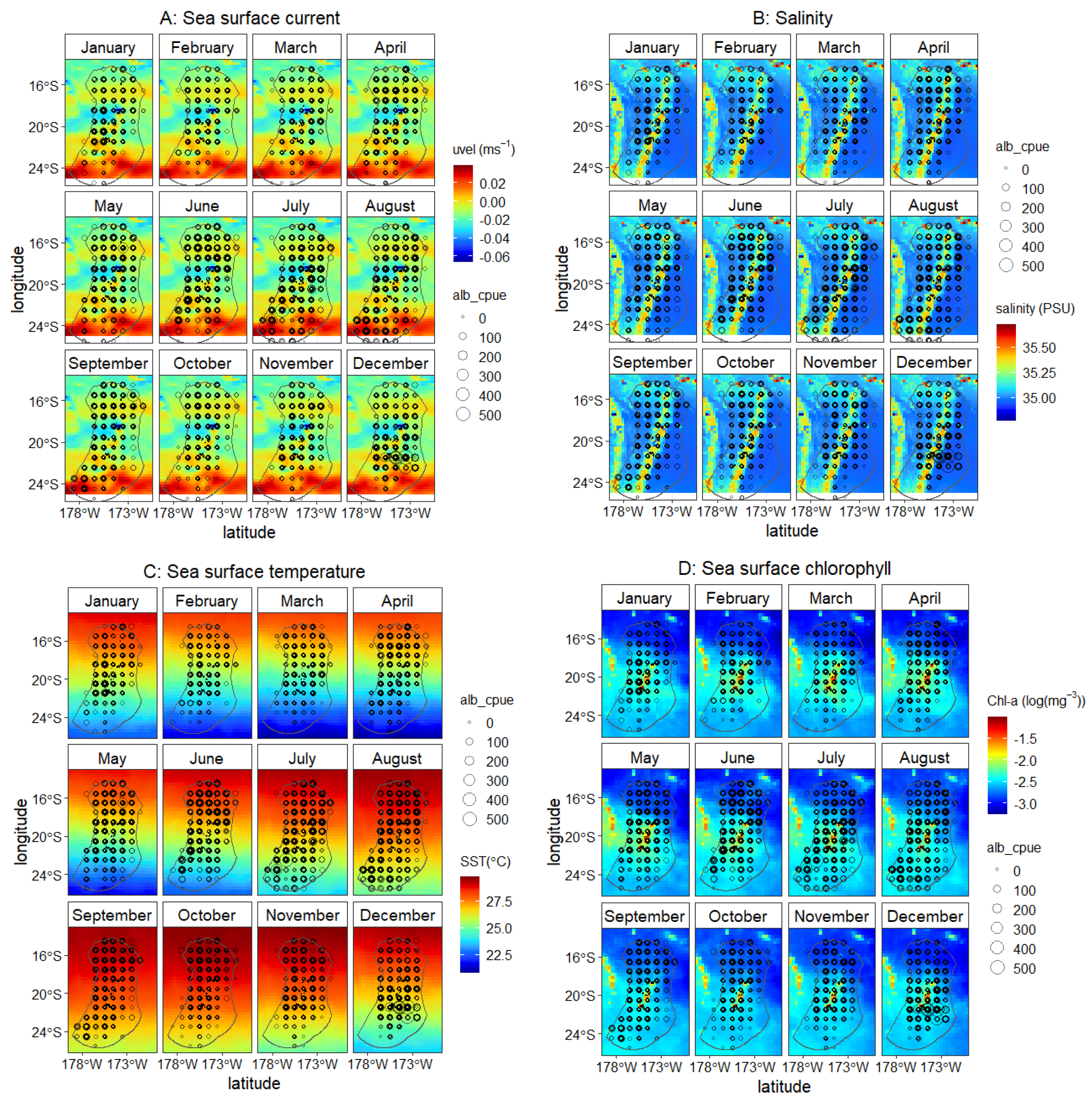
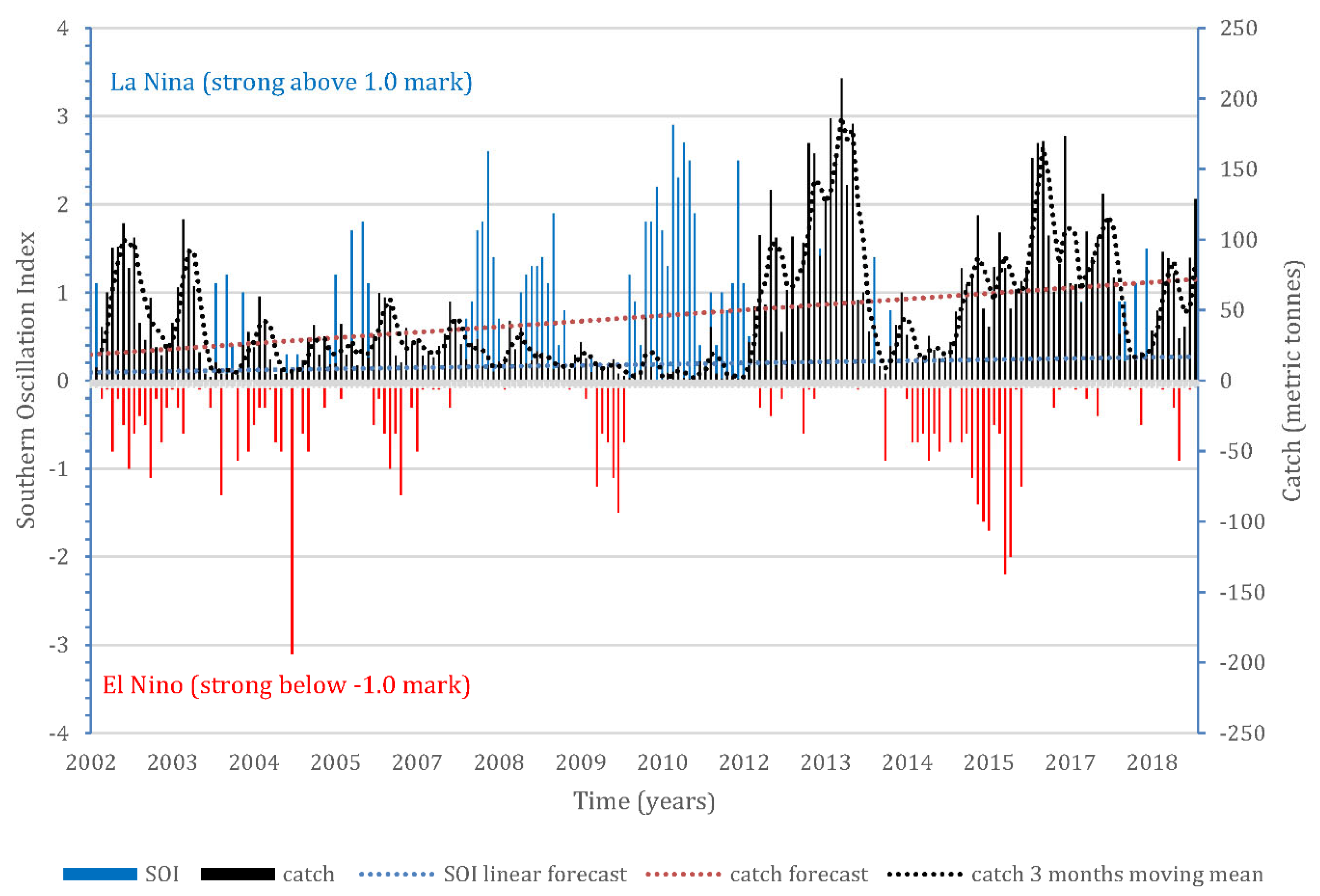
| No. of Longline Vessels | Catch Size (Metric Tons) | CPUE (No. of Fish/100 Hooks/Year) | |||||||||
|---|---|---|---|---|---|---|---|---|---|---|---|
| Year | Total No. of Hooks | Domestic | Foreign | Albacore | Bigeye | Skipjack | Yellowfin | Albacore | Bigeye | Skipjack | Yellowfin |
| 2002 | 38,526 | 17 | - | 740 | 124 | 4 | 170 | 30,890 | 5097 | 209 | 6918 |
| 2003 | 46,622 | 23 | - | 489 | 76 | 15 | 240 | 19,164 | 2702 | 754 | 8686 |
| 2004 | 26,348 | 20 | - | 237 | 47 | 3 | 208 | 10,607 | 2120 | 166 | 9215 |
| 2005 | 28,521 | 13 | - | 235 | 78 | 3 | 123 | 10,290 | 3609 | 163 | 5653 |
| 2006 | 33,818 | 11 | - | 383 | 83 | 2 | 176 | 15,835 | 3859 | 101 | 7439 |
| 2007 | 31,347 | 12 | - | 336 | 109 | 1 | 278 | 14,518 | 4967 | 43 | 12,314 |
| 2008 | 22,432 | 9 | - | 227 | 72 | 0 | 248 | 10,355 | 3441 | 19 | 11,118 |
| 2009 | 11,112 | 6 | - | 146 | 33 | 1 | 97 | 7444 | 1776 | 49 | 5308 |
| 2010 | 6927 | 6 | - | 105 | 19 | 1 | 40 | 4348 | 1064 | 35 | 2513 |
| 2011 | 8703 | 3 | - | 88 | 14 | 2 | 142 | 3170 | 824 | 72 | 6960 |
| 2012 | 48,766 | 4 | - | 829 | 126 | 4 | 379 | 19,846 | 2976 | 121 | 11,488 |
| 2013 | 109,494 | 3 | 19 | 1583 | 230 | 9 | 640 | 36,947 | 5477 | 210 | 17,078 |
| 2014 | 31,357 | 4 | 19 | 284 | 40 | 8 | 378 | 8742 | 1484 | 305 | 14,785 |
| 2015 | 45,302 | 4 | 14 | 724 | 129 | 13 | 755 | 19,822 | 4104 | 364 | 23,191 |
| 2016 | 58,498 | 4 | 4 | 1265 | 159 | 31 | 895 | 32,618 | 4457 | 943 | 28,260 |
| 2017 | 55,438 | 6 | 8 | 874 | 129 | 41 | 871 | 23,328 | 3740 | 1290 | 29,104 |
| 2018 | 30,186 | 6 | 4 | 677 | 63 | 12 | 336 | 21,489 | 2486 | 485 | 13,895 |
| Total allowable catches for each species (metric tons) | 2500 | 2000 | Unlimited | 2000 | Manage through WCPFC harvest strategic plan and TMDP | ||||||
Disclaimer/Publisher’s Note: The statements, opinions and data contained in all publications are solely those of the individual author(s) and contributor(s) and not of MDPI and/or the editor(s). MDPI and/or the editor(s) disclaim responsibility for any injury to people or property resulting from any ideas, methods, instructions or products referred to in the content. |
© 2023 by the authors. Licensee MDPI, Basel, Switzerland. This article is an open access article distributed under the terms and conditions of the Creative Commons Attribution (CC BY) license (https://creativecommons.org/licenses/by/4.0/).
Share and Cite
Vaihola, S.; Kininmonth, S. Ecosystem Management Policy Implications Based on Tonga Main Tuna Species Catch Data 2002–2018. Diversity 2023, 15, 1042. https://doi.org/10.3390/d15101042
Vaihola S, Kininmonth S. Ecosystem Management Policy Implications Based on Tonga Main Tuna Species Catch Data 2002–2018. Diversity. 2023; 15(10):1042. https://doi.org/10.3390/d15101042
Chicago/Turabian StyleVaihola, Siosaia, and Stuart Kininmonth. 2023. "Ecosystem Management Policy Implications Based on Tonga Main Tuna Species Catch Data 2002–2018" Diversity 15, no. 10: 1042. https://doi.org/10.3390/d15101042
APA StyleVaihola, S., & Kininmonth, S. (2023). Ecosystem Management Policy Implications Based on Tonga Main Tuna Species Catch Data 2002–2018. Diversity, 15(10), 1042. https://doi.org/10.3390/d15101042








